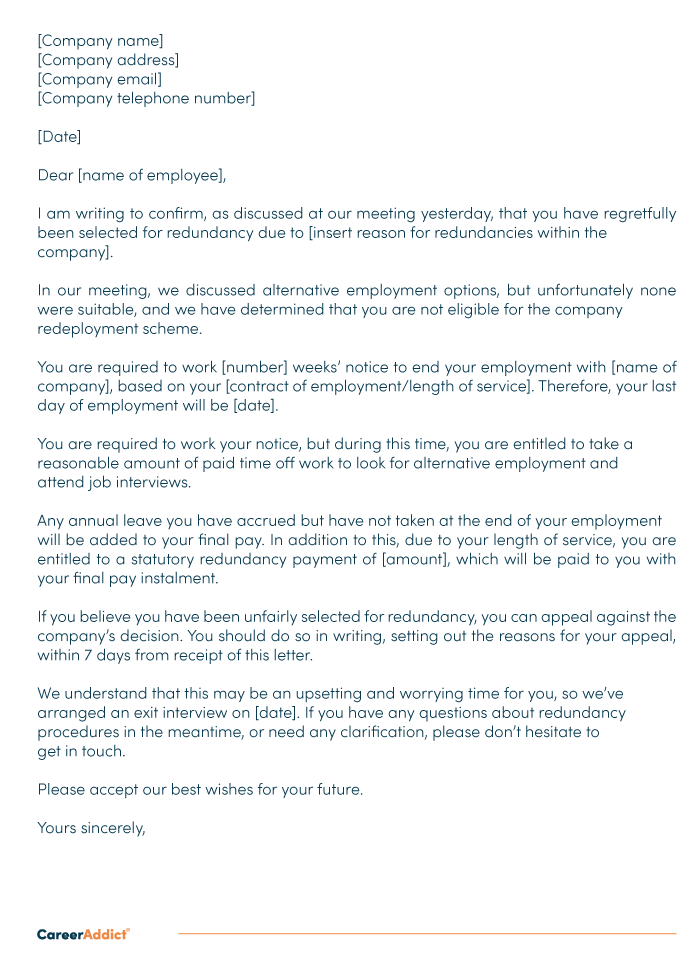Who Pays Redundancy Money? An In-depth Overview for Employers and Employees
Who Pays Redundancy Money? An In-depth Overview for Employers and Employees
Blog Article
Investigating the Interaction In Between Firm Redundancy and Business Versatility for Future Growth
In the vibrant landscape these days's service world, the elaborate connection between company redundancy and organizational adaptability arises as a vital element for continual development and success. Business often encounter the challenge of striking a fragile equilibrium between maintaining a level of redundancy to reduce threats and fostering versatility to react quickly to the ever-evolving market demands. This fragile interplay holds the crucial to not only making it through in stormy times but likewise thriving when faced with unpredictability. As we discover the multifaceted dimensions of this interaction, intriguing insights right into just how organizations navigate these intricacies to lead the way for future growth wait for.
Significance of Business Redundancy
Firm redundancy is a crucial element that improves organizational durability and mitigates functional dangers. By integrating redundancy actions within the organizational framework, companies can better endure unpredicted disturbances and variations in the organization environment. Redundancy functions as a tactical buffer, permitting firms to adapt and respond effectively to unanticipated obstacles without jeopardizing vital operations.
One key facet of the value of company redundancy is its role in making certain connection throughout times of dilemma. When faced with abrupt adjustments or emergencies, redundant systems, sources, or employees can step in to maintain vital features and prevent prevalent interruptions. This connection not only safeguards the firm's track record and client count on but additionally lessens monetary losses and operational downtime.

Strategies for Organizational Adaptability

Another essential method is purchasing modern technology and infrastructure that can support versatility and scalability. Applying digital tools, automation, and data analytics can enhance operations, enhance effectiveness, and give valuable insights for informed decision-making. Moreover, producing adaptable organizational structures that enable fast adjustments to market dynamics and client requirements is necessary for remaining affordable in a swiftly advancing environment. By proactively identifying potential interruptions and chances, organizations can proactively adapt and prosper in an ever-changing service landscape.
Balancing Redundancy and Adaptability
Attaining a harmonious equilibrium between functional redundancy and business adaptability is critical in browsing the complexities of a dynamic service environment. Striking the best equilibrium in between redundancy and adaptability is a delicate procedure that calls for a deep understanding of the organization's objectives, industry dynamics, and danger resistance.
To accomplish this equilibrium, firms require to carry out routine evaluations of their procedures to determine areas where redundancy is needed for danger mitigation and where versatility can drive advancement and development. Carrying out versatile frameworks, cultivating a society of constant discovering and enhancement, and motivating open communication across all degrees of the company are crucial approaches to balance redundancy and versatility properly. By straightening these 2 important aspects, firms can position themselves for lasting development and success in an ever-changing service landscape.
Situation Studies on Adaptation Success
In analyzing instances of effective business adaptation, it comes to be obvious that the interplay in between functional redundancy and adaptability is a specifying consider shaping resilient businesses. One engaging situation study is that of Netflix. Originally a DVD rental service, Netflix showed exceptional adaptability by transitioning right into a streaming system when digitalization disrupted the sector. By purposefully buying technology and web content development, Netflix not just flourished yet made it through in a swiftly progressing market. Another standout instance go to the website is Amazon. Starting as an on-line bookstore, Amazon continually adapted its service model, broadening right into diverse markets such as cloud computing and fabricated intelligence. This adaptability enabled Amazon to remain ahead of rivals and fulfill changing customer needs. Finally, Adobe gives a noteworthy picture of effective adaptation. The firm shifted from offering software program licenses to a subscription-based model, making sure reoccuring income streams and boosted customer interaction. These instance researches underscore the significance of operational redundancy combined with business flexibility in cultivating long-term growth and competitiveness.
Structure Durability for Future Growth
Building durability for future growth calls for a tactical alignment of functional processes with market characteristics and emerging patterns. Companies need to adapt to transforming atmospheres by cultivating a culture of adaptability, development, and continual enhancement.
Moreover, cultivating strong partnerships with stakeholders, such as clients, staff members, suppliers, and the area, is essential for preserving and weathering unpredictabilities count on and assistance throughout turbulent times. Efficient interaction and transparency play a crucial role in building strength, as they help line up assumptions and facilitate partnership in browsing uncertainties.
Additionally, companies need to prioritize understanding and development efforts to upskill staff members and equip them with the required devices to adapt to altering conditions. By buying their labor force, firms can enhance their adaptability and dexterity, inevitably strengthening their durability for lasting future development.
Conclusion

In the dynamic landscape of today's organization world, the intricate connection between company redundancy and business adaptability arises as a vital aspect for continual growth and success. Business commonly deal with the obstacle of striking a fragile equilibrium between Discover More Here maintaining a degree of redundancy to mitigate threats and cultivating versatility to respond swiftly to the ever-evolving market needs.To achieve this balance, companies need to carry out regular assessments of their operations to recognize areas where redundancy is required for risk reduction and where adaptability can drive advancement and growth.In verdict, the interplay in between company redundancy and business flexibility is essential for future development. Building durability via a combination of redundancy and versatility will certainly ensure that business are prepared for the difficulties of the future.
Report this page